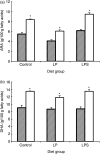Maternal long-chain PUFA supplementation during protein deficiency improves brain fatty acid accretion in rat pups by altering the milk fatty acid composition of the dam
- PMID: 25191591
- PMCID: PMC4153033
- DOI: 10.1017/jns.2012.25
Maternal long-chain PUFA supplementation during protein deficiency improves brain fatty acid accretion in rat pups by altering the milk fatty acid composition of the dam
Abstract
Long-chain PUFA (LC-PUFA) are important for fetal and neonatal brain development. However, their accretion in the brain is compromised during maternal protein restriction. Hence, we investigated the effect of maternal supplementation with n-3 DHA plus n-6 arachidonic acid (ARA) at a low protein level (9 %) on offspring brain fatty acid accretion using Wistar rats (nine rats per group) randomly fed a control (C), a low-protein (LP) or a low-protein DHA + ARA-supplemented (LPS) diet during gestation and lactation. At birth, pups from the LPS group had the highest brain DHA and n-3 fatty acid levels (P = 0·001), whereas pups from the LP group had the highest MUFA (P = 0·05) but the lowest DHA and total n-3 PUFA levels (P = 0·000). During lactation, pups from the LPS group accrued significantly more α-linolenic acid (P = 0·003), EPA (P = 0·02) and DHA (P = 0·000) in brain lipids than pups from the LP group, whereas brain lipids of pups from the LP group had markedly increased levels of the n-3 deficiency marker docosapentaenoic acid and n-6:n-3 ratio (P = 0·000). Owing to supplementation, milk from LPS dams had the highest DHA and ARA, but lower SCFA and medium-chain fatty acids as compared with milk from C and LP dams during early lactation, but normalised by mid-lactation. To conclude, adverse effects of restricted maternal protein intake on LC-PUFA accretion in the brain of offspring were ameliorated by alterations in maternal milk fatty acid profile due to supplementation. Results underscore the importance of LC-PUFA for protein-deficient mothers during gestation as well as lactation to achieve the optimum brain LC-PUFA status of progeny.
Keywords: ALA, α-linolenic acid; ARA, arachidonic acid; Brain lipids; LA, linoleic acid; LC-PUFA, long-chain PUFA; LP, low protein; LPS, low protein DHA + ARA supplemented; Long-chain PUFA; Maternal supplementation; Milk lipid composition; Protein restriction.
Figures

References
-
- Cheatham CL, Colombo J & Carlson SE (2006) n-3 Fatty acids and cognitive and visual acuity development: methodological and conceptual considerations. Am J Clin Nutr 83, Suppl., 1458S–1466S - PubMed
-
- Sinclair AJ (1975) Long chain polyunsaturated fatty acids in the mammalian brain. Proc Nutr Soc 34, 287–291 - PubMed
-
- Clandinin MT, Chappell JE, Leong S, et al. (1980) Intrauterine fatty acid accretion rates in human brain: implications for fatty acid requirements. Early Hum Dev 4, 121–124 - PubMed
-
- Green P & Yavin E (1996) Fatty acid composition of late embryonic and early postnatal rat brain. Lipids 31, 859–865 - PubMed
-
- Bowen RA & Clandinin MT (2005) Maternal dietary 22 : 6n-3 is more effective than 18 : 3n-3 in increasing the 22 : 6n-3 content in phospholipids of glial cells from neonatal rat brain. Br J Nutr 93, 601–611 - PubMed
LinkOut - more resources
Full Text Sources
Other Literature Sources
Research Materials

